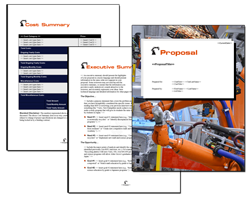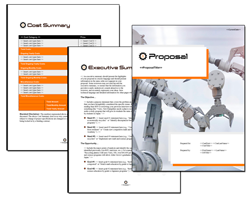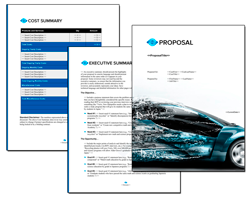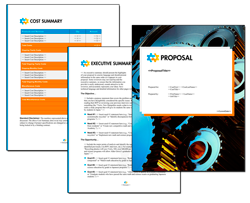
How to Write a Manufacturing Business Proposal: Best Practices & Tips
Want to know how to write a manufacturing business proposal that gets results? This article will guide you through each step, from outlining your company's mission to detailing financial projections. You'll learn how to tailor your proposal to meet industry standards and attract investors. You'll have a clear template to follow by the end.
Key Takeaways
- A manufacturing business proposal is a comprehensive blueprint for success, outlining critical aspects such as regulatory compliance and supply chain management to attract investors and stakeholders.
- Key elements of a manufacturing business proposal include an executive summary, company overview, product or service description, market analysis, financial projections, and an operations plan, all essential for creating a persuasive business plan.
- Using proposal writing tools like Proposal Kit can enhance the effectiveness and professionalism of proposals, while thorough proofreading is necessary to avoid mistakes that may harm credibility.
Challenges Faced by the Manufacturing Sector in Today's Business Environment

In today's dynamic business landscape, manufacturers face several significant challenges, notably stemming from unpredictable government tariff policies. While the intent behind these tariffs may be to encourage companies to repatriate manufacturing operations to the U.S., the absence of a robust underlying government policy offering clear incentives or subsidies has introduced considerable uncertainty.
This unpredictable tariff environment increases operational costs, forcing manufacturers to reassess their production strategies continuously. Rather than bringing manufacturing back to the United States, this uncertainty can inadvertently drive companies to shift production to countries with more favorable tariff structures and lower production costs.
Companies struggle to develop long-term plans when tariff policies change rapidly or without clear direction. The lack of consistent incentives and support measures, such as subsidies or clear regulatory guidelines, compounds these issues. Without targeted government policies to stabilize and support domestic manufacturing, businesses may find relocation to more predictable international markets the most viable option.
Moreover, these shifting policies can disrupt supply chains, complicate financial projections, and negatively impact competitiveness. As businesses weigh their options, the perceived risks associated with domestic manufacturing under volatile tariff conditions could significantly deter investment, innovation, and expansion within the U.S.
For manufacturing businesses drafting proposals, addressing how your company will navigate these uncertainties and mitigate related risks is crucial. Clearly articulating strategies for adapting to tariff policy fluctuations and highlighting proactive measures, such as diversified sourcing and flexible operational planning, will demonstrate preparedness to potential investors and stakeholders.
Advanced Manufacturing: AI, Robotics, and Automation
Manufacturing rapidly evolves due to significant advances in artificial intelligence (AI), robotics, and software-driven automation. These technologies are revolutionizing the factory floor by significantly reducing the reliance on human labor, which decreases costs, increases productivity, and enhances overall product quality.
AI-powered automation systems and intelligent robotics enable manufacturers to achieve unprecedented efficiency and precision. Automated processes driven by advanced algorithms can analyze vast amounts of data in real time, optimizing operations and reducing waste. Robotics integrated with AI capabilities perform complex tasks consistently and tirelessly, significantly reducing errors common in manual production.
Factories leveraging these advanced manufacturing techniques experience substantial gains in productivity and operational flexibility. The shift to automation reduces production downtime, enhances quality control through precise monitoring and predictive maintenance, and streamlines inventory management. Automated factories can operate around the clock without significant additional costs, maximizing output and profitability.
However, transitioning to advanced manufacturing also brings challenges, particularly in workforce displacement and the need for specialized technical skills. Businesses must strategically plan workforce transitions, investing in training programs to prepare employees for new, technology-oriented roles. Proposals addressing advanced manufacturing should clearly outline how the company intends to manage these workforce dynamics and integrate cutting-edge technologies to maintain a competitive edge.
Understanding the Importance of a Manufacturing Business Proposal

A manufacturing business proposal is not just a document; it's a blueprint for success. It outlines the goals and strategies specific to manufacturing operations, ensuring meticulous planning and execution of every business aspect. One of the key elements that set manufacturing business plans apart is the need to address regulatory compliance and supply chain management, both of which are critical for operational success in a new manufacturing business. A manufacturing business plan example can serve as a valuable reference in this process.
Investors and stakeholders typically need a detailed example business plan to assess the feasibility and potential of a new business manufacturing venture for potential buyers. Pitching projects, proposing internal initiatives, or collaborating on joint ventures - a well-prepared business plan can unlock new opportunities.
Remember, your proposal is not just a formality; it's a strategic tool that can propel your business growth forward.
Key Elements of a Manufacturing Business Proposal
The cornerstone of any successful manufacturing business plan lies in its structure. A well-structured proposal includes several key sections that together create a comprehensive roadmap for the business. These sections serve as a template for starting and growing a manufacturing company, ensuring that all critical aspects are covered.
From the introduction and executive summary to the detailed descriptions of the company, product, market analysis, financial projections, operations plan, sales and marketing strategy, and supporting documents, each section plays a vital role. Understanding these key elements will help you create a robust and persuasive proposal that addresses all necessary topics.
Introduction and Executive Summary

The executive summary is the most crucial section of your business plan or proposal. It should convey key information effectively. It provides a concise overview of the major sections, including your mission, market research, and financials, capturing the essence of your proposal. The executive summary provides a snapshot of your business and its strategy for success. Include a brief description of your target audience, product, market analysis, financial plan, funding requirements, and expected return on investment.
Typically written last, the executive summary accurately captures all key points. The introduction, preceding the executive summary, includes a cover letter, a title page, and a table of contents. This section sets the tone for the entire proposal and should be written carefully to make a strong first impression.
Company Overview
The company overview section briefly summarizes your organization, including a company description. It should convey your mission statement, history, and leadership structure. This section is crucial as it gives potential investors and partners a clear understanding of your business's foundation and direction. Highlighting your company's strengths and unique aspects can set you apart from competitors.
Key leadership figures play a pivotal role in the companies' success. Their expertise and leadership philosophy, which encourages responsibility and mutual respect, are essential components of your company's growth story, along with the contributions of key members.
Additionally, the Board of Directors, consisting of company owners, officers, and directors, oversees crucial business decisions.
Product or Service Description

A detailed product or service description is vital for helping potential clients understand what you offer and why it stands out. This section should include unique features, quality control procedures, patents, and manufacturing processes. A clear and detailed description helps define the product and its purpose, making it easier for customers to see its value.
Details to include include the size, material, and type of products manufactured, such as molds and prototypes. Highlighting unique features and quality control practices linked to the manufacturing process, such as inspection and testing for quality assurance, can significantly boost your product's appeal.
Conducting Market Analysis
Market analysis is the backbone of your manufacturing proposal. It justifies business decisions and showcases your industry knowledge. This section should include detailed information on market opportunities, customer demographics, psychographics, and buying habits. Understanding your target market allows you to tailor business strategies to effectively meet their needs. Additionally, conducting an industry analysis can further enhance your understanding of the competitive landscape.
Staying abreast of market trends allows businesses to anticipate changes and identify new opportunities for differentiation. Utilizing tools like SWOT analysis helps identify your company's strengths and weaknesses relative to competitors, guiding strategic decisions and enhancing your market positioning.
Detailing Financial Projections

Financial projections are a crucial component of any business plan, providing estimates of future income and expenses based on existing or assumed financial data. They are essential for both startups and established businesses when seeking funding from lenders or investors. The projections should include key components such as startup costs, payroll, sales forecasts, operating expenses, cash flow statements, and income statements.
Including both best-case and worst-case scenarios in your financial projections prepares you for various outcomes and demonstrates thorough planning. Regularly comparing actual financial statements with projections ensures your financial plans remain relevant and accurate, boosting credibility with potential investors.
Crafting an Operations Plan
An operations plan outlines the objectives and operational strategies essential for the growth of your manufacturing business. This section details daily business activities and goals, aiding in smooth organization and management of operations. Include detailed information about your facilities, equipment, and their operational status.
Plans for facility expansion, such as creating an injection-mold manufacture plant, are crucial for controlling all operations in-house. Additionally, the staffing strategy, including cross-trained factory-floor technicians, and quality control processes like LEAN Manufacturing, Rapid Prototyping, and Six Sigma, ensure that your business maintains high standards and operational efficiency in the manufacturing industry.
Developing a Sales and Marketing Strategy

A robust sales and marketing strategy is vital for effective engagement with your target market. Identifying specific market segments and integrating both owned and paid marketing channels can maximize your reach and impact. Allocating a percentage of revenue for marketing is generally recommended for industrial and manufacturing firms to ensure adequate exposure, considering the market size.
A proactive service team can help maintain customer relationships after the sale, enhancing overall marketing effectiveness. Analyzing marketing efforts is essential to understanding ROI and improving future strategies.
Competitive analysis insights should inform your action plan, helping you maintain a strong market position. Monitoring competitors' pricing strategies can provide valuable insights into your own pricing decisions and competitiveness.
Addressing Client Needs and Solutions
To create a winning proposal, focus on the potential client's needs, desires, and limitations. Understanding the client's operational processes and challenges allows you to tailor your solutions to their specific needs. This section should articulate the client's problem and align your solutions with their strategic goals to demonstrate value.
Clear and concise communication ensures the client's needs and solutions are effectively conveyed. Neglecting to clearly define the target audience can result in a misaligned product that fails to meet customer needs.
Showcasing Your Competitive Advantage
Understanding your competitors is key to showcasing your competitive advantage. A thorough competitive analysis should assess both direct and key competitors, as well as indirect competitors, highlighting their strengths and weaknesses. Tools like SWOT analysis categorize information, clarifying your competitive positioning.
Developing an action plan based on competitive analysis insights can help you implement effective strategies for improvement. Highlighting specific competitive advantages, such as speed, quality, and the use of top-quality machinery, can save time and enhance your market position.
Additionally, leveraging unique features like a Virtual Design Center can set your business apart from competitors.
Here are some related samples included in every downloadable Proposal Pack
The AI Writer generates a first draft of these templates - customized to your company, client, and project - in just minutes, giving you a head start on editing. Get any Proposal Pack or Proposal Kit Professional, and all of these samples, and the AI Writer are included.
- Software Automation Sample Proposal
- Process Improvement Sample Proposal
- Transportation Shipping Services Sample Proposal
- Manufacturing Process Improvement Sample Proposal
- Import Export Services Sample Proposal
- Manufacturing and Distribution Sample Proposal
- Welding and Fabrication Services Sample Proposal
- 3D Printing Prototyping Services Sample Proposal
Here are some related downloadable templates
The AI Writer generates a first draft of these templates - customized to your company, client, and project - in just minutes, giving you a head start on editing. Get any Proposal Pack or Proposal Kit Professional, and all of these templates and the AI Writer are included.
Using Proposal Kit for a Professional Edge
Utilizing Proposal Kit can significantly improve the efficiency and effectiveness of your proposal writing process. Proposal Kit Professional offers extensive content, including legal contracts, brandable design theme packs, and advanced software features such as customizable quoting databases.
The Proposal Kit includes thousands of topic pages with instructions, examples, and sample proposals, making it easier to write about various topics. The software provides templates, design themes, line item quoting software, and an AI Writer to assist in creating professional and polished proposals.
Common Mistakes to Avoid

One common mistake among new manufacturers is not taking the planning process seriously, leading to inadequate preparation for their business. Rushing through the proposal process often results in overlooked errors and critical omissions. Effective communication relies on error-free content, as even minor mistakes can damage a company's credibility.
Proofreading goes beyond correcting grammar; it ensures clarity, coherence, and consistency in written materials. Mistakes in proposals can jeopardize important business deals, highlighting the need for thorough proofreading.
Final Review and Proofreading
The final step in creating a proposal is to have it reviewed by a professional proofreader or editor. Professional proofreading services enhance your brand reputation by delivering polished, error-free content. Hiring professionals for proofreading allows you to focus on your core work while ensuring high-quality written materials.
Utilizing proofreading services is crucial for presenting a polished proposal that stands out to potential clients. This step ensures your proposal is error-free, clear, coherent, and compelling.
Another option is to use online AI-driven proofreading and grammar-checking tools.
Summary
In summary, writing an effective manufacturing business proposal involves several critical steps, from understanding its importance to detailing financial projections and developing a robust sales and marketing strategy. Each section of the proposal plays a vital role in presenting a comprehensive and persuasive plan to potential investors and partners.
Following the best practices outlined in this guide, you can create a proposal that meets and exceeds expectations. Remember, a well-crafted proposal is key to unlocking new opportunities and achieving your business goals. Take the time to plan, write, and review your proposal meticulously, and watch your manufacturing business thrive.
 Proposal Kit Professional provides the most content, including legal contracts and a free design theme pack. Plus, advanced software features include custom branding and customizable quoting databases.
Proposal Kit Professional provides the most content, including legal contracts and a free design theme pack. Plus, advanced software features include custom branding and customizable quoting databases. Proposal Pack for Any Business covers this type of proposal and includes samples. There are also some commonly used specialty design themes available:
Proposal Pack for Any Business covers this type of proposal and includes samples. There are also some commonly used specialty design themes available:Photo Design Proposal Packs
Line Art Design Proposal Packs
 Proposal Pack Aerospace #1
Proposal Pack Aerospace #1 Proposal Pack Aerospace #2
Proposal Pack Aerospace #2 Proposal Pack Concepts #1
Proposal Pack Concepts #1 Proposal Pack Concepts #11
Proposal Pack Concepts #11 Proposal Pack Concepts #4
Proposal Pack Concepts #4 Proposal Pack Concepts #5
Proposal Pack Concepts #5 Proposal Pack Contemporary #1
Proposal Pack Contemporary #1 Proposal Pack Global #1
Proposal Pack Global #1 Proposal Pack Global #2
Proposal Pack Global #2 Proposal Pack Global #3
Proposal Pack Global #3 Proposal Pack Industrial #1
Proposal Pack Industrial #1 Proposal Pack Industrial #2
Proposal Pack Industrial #2 Proposal Pack Industrial #4
Proposal Pack Industrial #4 Proposal Pack Transportation #1
Proposal Pack Transportation #1 Proposal Pack Transportation #2
Proposal Pack Transportation #2 Proposal Pack Transportation #3
Proposal Pack Transportation #3 Proposal Pack Transportation #4
Proposal Pack Transportation #4
Frequently Asked Questions
What are the key elements of a manufacturing business proposal?
The key elements of a manufacturing business proposal are the Introduction, Executive Summary, Company Overview, Product/Service Description, Market Analysis, Financial Projections, Operations Plan, and Sales and Marketing Strategy. Including these components is essential for a comprehensive proposal.
Why is market analysis important in a manufacturing business plan?
Market analysis is important in a manufacturing business plan as it provides essential insights into market opportunities, customer demographics, and industry trends. It thereby justifies business decisions and demonstrates expertise. Conducting thorough market analysis enhances strategic planning and competitiveness.
What should be included in the financial projections section of a manufacturing business plan?
Financial projections in a manufacturing business plan must encompass startup costs, payroll, sales forecasts, operating expenses, cash flow statements, and income statements, along with both best-case and worst-case scenarios. This comprehensive approach ensures a well-rounded understanding of the financial landscape.
How can Proposal Kit help you write a manufacturing business proposal?
Proposal Kit can significantly enhance your manufacturing business proposal by offering templates, design themes, quoting software, and an AI Writer. These streamline the writing process and ensure professionalism. This comprehensive support facilitates the creation of tailored proposals that meet specific needs in the manufacturing sector.
What are some common mistakes to avoid when writing a manufacturing business proposal?
To create a credible and professional manufacturing business proposal, it is crucial to avoid rushing through the writing process, neglecting thorough planning, and overlooking proofreading. Ensuring effective communication and presenting error-free content will significantly enhance the proposal's quality.



 Cart
Cart
 Are you just looking for a template, sample, or software for your manufacturing proposals? Click these links to skip down the page and get right to it.
Are you just looking for a template, sample, or software for your manufacturing proposals? Click these links to skip down the page and get right to it.



 Facebook
Facebook YouTube
YouTube Bluesky
Bluesky Search Site
Search Site